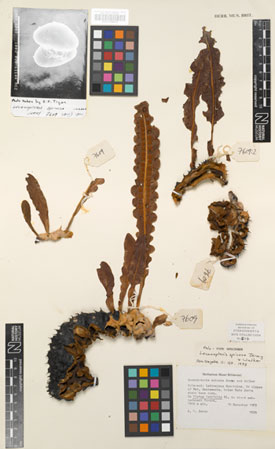Taxonomy

Holotype of Lecanopteris spinosa mounted on a herbarium sheet in the Museum collection © Natural History Museum, London
Lecanopteris is in the large global family, Polypodiaceae. 13 species of Lecanopteris are currently recognised.
Lecanopteris has been split by some researchers into 2 genera (or into 2 sections of Lecanopteris) on the basis of 2 main features:
- Myrmecopteris has
- rhizome clothed with distinctive scales
- sori (clusters of spore capsules) that are not marginal
- Lecanopteris has
- rhizome that is not scaly
- sori on reflexed marginal lobes of the frond
L. spinosa is intermediate between these 2 groups, having no scales but with sori not marginal. Thus its discovery supported the recognition of a single genus.
Subsequent research suggested that since Myrmecopteris seemed to be closely related to the genus Phymatodes, Lecanopteris in the broad sense could not be monophyletic and the 2 subgenera might have had different origins. However, more recent DNA studies support Lecanopteris as a monophyletic genus comprising closely related species derived from a common ancestor.
Morphology

Lecanopteris spinosa - rhizome of the holotype specimen in the Museum collection © P Lund, Natural History Museum, London
In Lecanopteris spinosa the rhizome is:
- creeping and much branched
- 2.5 to 4.0cm in diameter
- pale green and glaucous when young, becoming black with age and without stomata
- grows continuously and dies back at the other end
- grows in 3 to 4 superimposed layers around a branch to form a ball-like clump up to 25cm across
- densely covered with strong spines up to 6mm long
- glabrous - lacks scales or hairs except when very young
- hollow - as it ages the pith cells in the centre dry out and shrink to form cavities exploited by ants
The morphology and internal structure of the rhizome varies in complexity according to the species. Most have a single gallery running through the rhizome and into the side branches but a few, including Lecanopteris spinosa, have a much more complex system of interconnecting galleries and chambers.
The fronds are:
- simple (sterile fronds) or lobed (fertile fronds)
- more-or-less sessile (not stalked)
- jointed to rhizome
- lamina (leaf blade) up to 30cm long and 3 to 4cm wide
- leathery
- glabrous
The sori are:
- round
- in 1 row on either side of the rachis (midrib)
- deeply immersed in the frond so they project on the upper surface
- naked, having no protective indusium - a characteristic of the Polypodiaceae
Look-alikes
Lecanopteris spinosa is unlikely to be confused with other species of Lecanopteris due to its unique combination of characters:
- rhizome forms ball-like clumps
- rhizome has many rigid spines but no scales
- fronds are simple or lobed
- sori are sunken and in 1 row on either side of the rachis
Toolbox
Glossary
Absorption
The process by which water and nutrients are absorbed and conveyed to the plant tissues and organs.
Domatium (plural: domatia)
Part of a plant that has been modified to provide protection for insects, mites or fungi.
Epiphytes
Plants that grow on another plant for support but are not parasitic.
Facultative
Not obligatory - can complete its life cycle independently.
Frond
Fern leaf.
Glaucous
With a waxy blue-green sheen.
Indusium
A structure that covers the sorus.
Monophyletic
Descended from a single common ancestor.
Rachis
A fern's midrib.
Rhizome
A fern's stem.
Sorus
Group of sporangia.
Sporangium
Spore capsule.